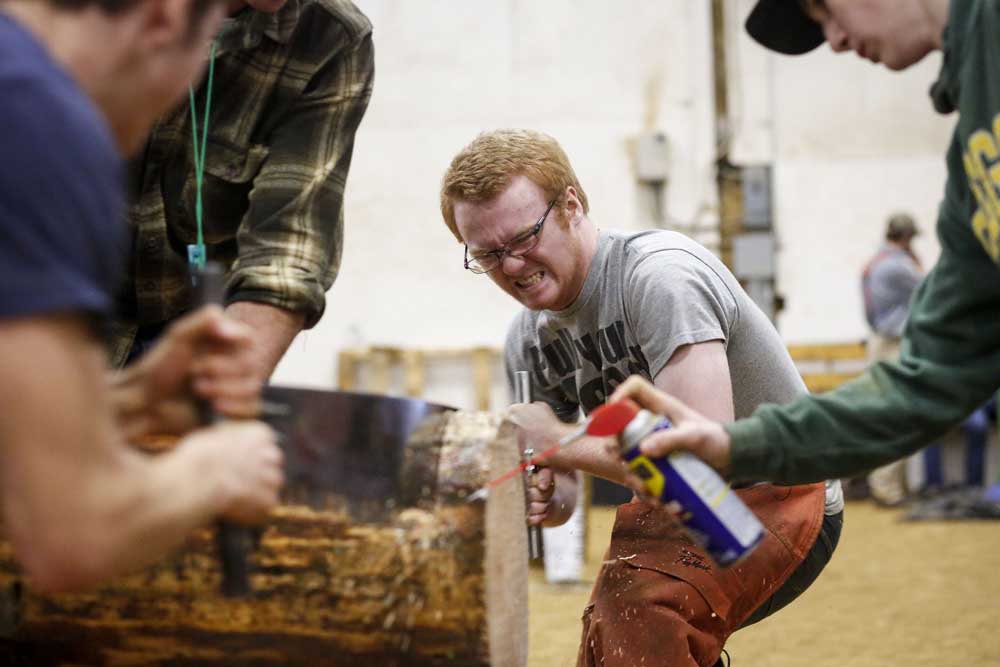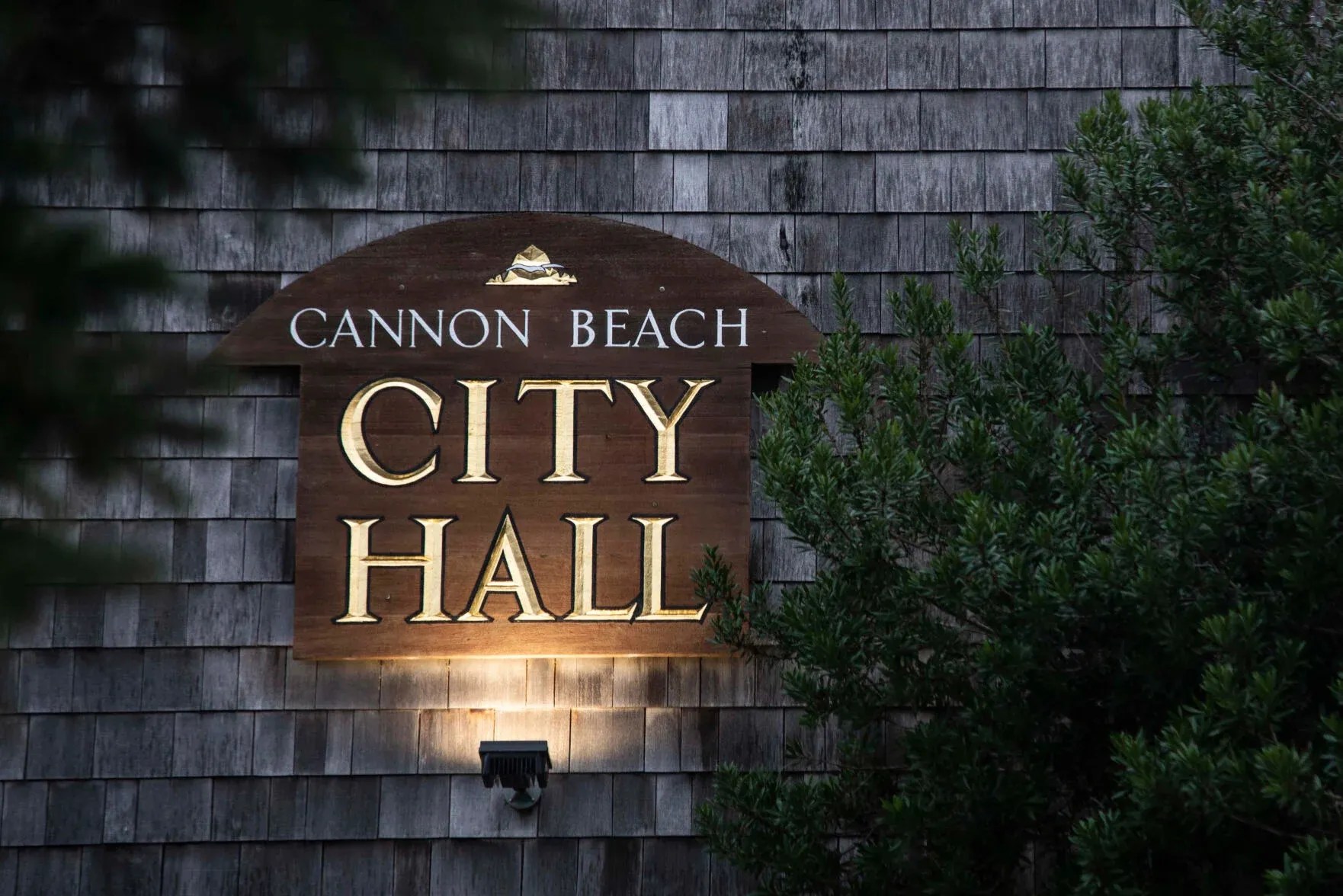With quick saws, Knappa gets back
Published 3:51 am Monday, February 9, 2015

- Devon Spencer, center, and Isaiah Ives, left, compete in double-buck sawing event during the Astoria Timber Festival Saturday at the Clatsop County Fairgrounds.
The Knappa Loggers’ FFA forestry team members had friendly revenge on their minds Saturday.
There was revenge against opponent Clatskanie, which beat Knappa last May to win its first FFA state forestry championship.
And there was friendly revenge against Clatskanie’s coach Jeff Skirvin, who two years earlier led Knappa to its fourth FFA state forestry championship before taking a teaching job with his alma mater.
The Loggers beat the Tigers by less than a second Saturday at the Clatsop County Fairgrounds in the finale of a three-school timber sports relay, the highlight of the Astoria Timber Festival & Job Fair.
The final round started with two students hurling double-sided axes at a large cookie cut of tree trunk painted into a target. After four throws, their teammates at the power buck station, clad in orange Kevlar chaps, each powered their chain saws through another cut of tree trunk.
A timber sports relay, said Knappa junior Meisha Boettcher, can be won or lost at the double-buck stage, a throwback to the days before chain saws, in which two-person teams stand on either side of a peg-and-raker crosscut saw to see who can saw off another wooden wafer the fastest.
Saturday, Boettcher lined up opposite Knappa alumnus Kevin Tilander, a prodigious forestry sport and science student. But with the Clatskanie’s double-buck team already halfway through their log by the time Tilander and Boettcher started, revenge looked like a long shot.
However small its forestry team, Tilander said, Knappa fields tough competitors there to win every event — and hopefully beat Skirvin’s team. He and Boettcher heaved, hoed and sawed through their log almost twice as fast as Clatskanie’s duo, leaving the two schools in a dead heat by the final event, the choker race.
Knappa senior Jimmy Hendrickson leaped off his perch and hurdled two logs laid crosswise in the main arena, on his way to a length of choker cable laid out in the middle of the arena. Hendrickson and his competitor were neck and neck with their chokers in tow, before his adversary dropped his cable. Hendrickson approached the log he’d leapt off, used his momentum to heave and wrap the cable around it, set his choker and took off back toward the finish line at the center of the arena.
A growing entourage of teammates followed as Hendrickson hurdled his last set of logs and crossed the finish line less than a second faster than his opponent from Clatskanie.
“I’m just waiting to take it to them at state,” said Hendrickson about his team’s goal of avenging their loss at last year’s state finals.
Leading Knappa’s FFA forestry program this year is Mike Rathfon, a 1999 Knappa graduate and its new forestry instructor, who admittedly has never competed in timber sports, but said he’s learning the ropes from his students.
In a log-rolling match afterward, senior Trentne Smith, after throwing an ax in the relay, showed off his footwork on a slippery, barkless tree trunk rotating on a spit over a small pool. With some frantic shuffling and expert balance, Smith stayed upright as it rolled clockwise and counterclockwise, while his opponent from Clatskanie took a fall into the pool time and time again, completing Knappa’s sweep of events Saturday.
But old feelings die hard. As some of the Knappa team members celebrated around the log-rolling pond, Smith motioned Skirvin over for a look at something interesting. He took the bait, as the rest of Knappa’s team snuck up from behind and gave their former coach a congratulatory splash.
Tuesday’s exhibition was a glorified practice before the FFA forestry club season begins Feb. 28 at Knappa High School, starting several months of events at each of the nine schools in Oregon that field timber sports teams. In May, teams travel to Bend for the FFA state finals.
Skirvin, a Clatskanie native who taught for a long time at Knappa and even sent his kids to school there, said it’s hard to compete against his former students, but it makes both sides better competitors. Playing with axes and saws at school is frowned upon, and Skirvin lets many of the competitors from Clatskanie and Knappa train at his private timber sports arena.
Only about 10 percent of timber sports athletes can make a living at it professionally, Skirvin said. While teaching art and forestry, logging in the summers, running forestry programs and recovering from a shoulder injury, the 42-year-old plans to compete for the sixth time in the upcoming Stihl Timbersports Series this spring.
While at Knappa, he also started a forestry program to teach students the technical aspects of harvesting timber and managing land, a program Rathfon, who attended OSU for a forestry degree, is continuing.
The FFA forestry program, the Astoria Timber Festival and its accompanying job fair all fit squarely into the regional context of Clatsop County, which is 95 percent forested. The Oregon State University Rural Studies Program estimated in 2012 that forest and wood products comprised approximately 28 percent of Clatsop County’s economic output.
During the 24th annual Community Leaders Forest Tour in September, an annual countywide plug for the impact of forestry, Executive Director Kevin Leahy of Clatsop Economic Development Resources said that Clatsop County has more than 1,700 of Oregon’s 79,000 forestry sector jobs. “At an average wage of about $65,000, that’s an annual payroll in Clatsop County of $111 million,” Leahy said.





